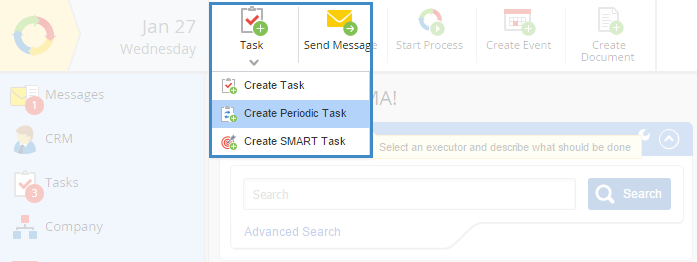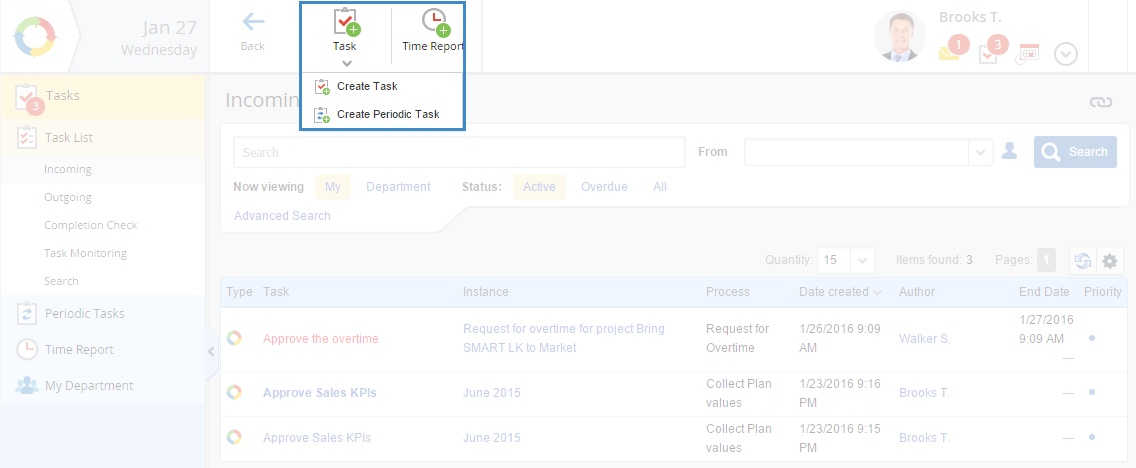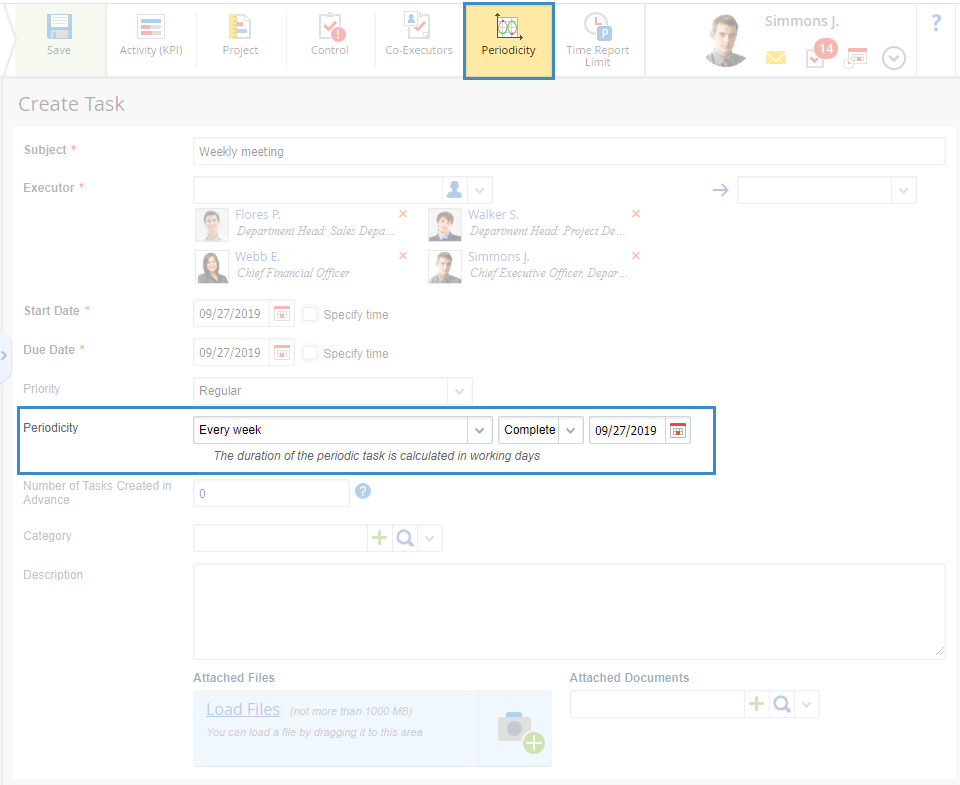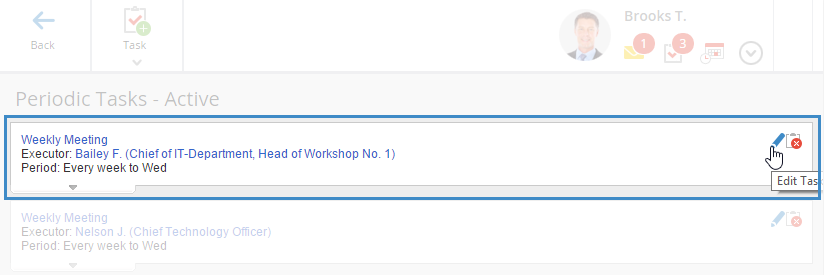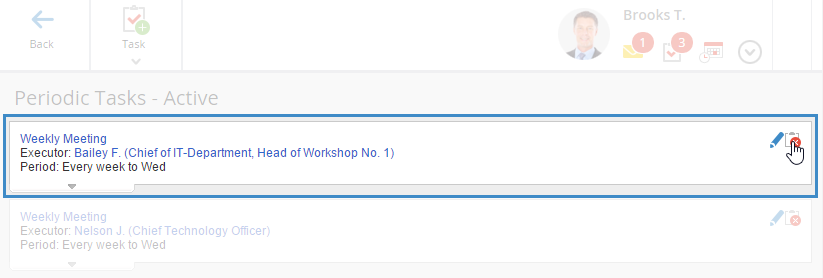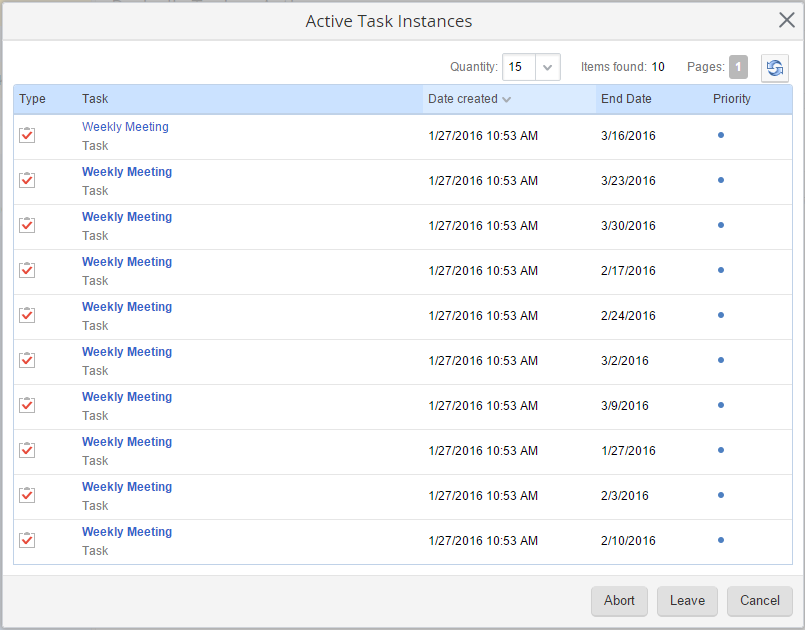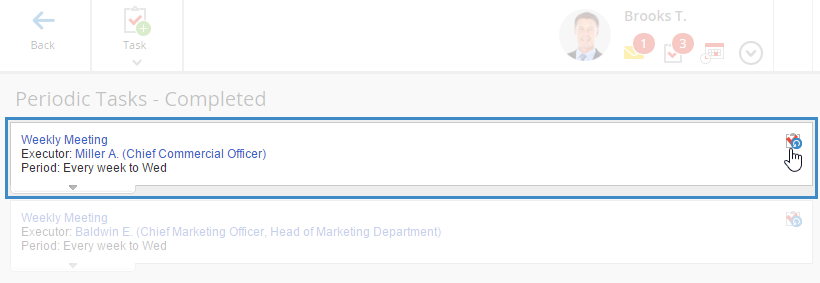Periodic task – is a task, which repeats with the configured periodicity. Periodic tasks are automatically created in the calendar for all the participants.
The Periodic Tasks subsection includes active and completed periodic tasks.
The Active subsection (fig. 1) shows the periodic tasks, created by the current user.
The Completed subsection (fig. 2) shows the completed periodic tasks, created by the current user.
To hide and show the periodic task instances, click  or
or  in the Active and Completed sections.
in the Active and Completed sections.
Create Periodic Task
You can create a periodic task in ELMA in several ways:
-
click Task - Create Periodic Task on the main page (fig. 3);
|
|
|
Fig. 3. "Task – Create Periodic Task" button
|
-
click Periodic Task in the system main menu (fig. 4);
|
|
|
Fig. 4. "Create Periodic Task" link in the main menu
|
-
|
|
|
Fig. 5. "Task – Create Periodic Task" button in the "Tasks" section
|
When you create a periodic task, the toolbar displays the Periodicity button. Click the button to add the Periodicity and Number of Tasks Created in Advance fields (fig. 6).
|
|
|
Fig. 6. Creating a periodic task
|
When active, the Periodicity button is dark-yellow.
Periodicity – select the task repeat periodicity from the drop-down list:
-
on working days (according to the business calendar) – a task instance will be created every working day (from Monday till Friday);
-
every day (regardless of the business calendar) – a task instance will be created every day, regardless of weekends and holidays;
-
every week – a task instance will be created every week, on the weekday, when the task was created, in accordance with the business calendar;
-
every month – a task instance will be created every month on the date, when the task was created, in accordance with the business calendar;
-
every quarter – a task instance will be created every three months on the date, the task was created, in accordance with the business calendar;
-
every year – a task instance will be created every year on the date, the task was created, in accordance with the business calendar.
Please note that when scheduling a repeating task, its duration and deadlines are calculated in line with the business calendar (except for the option every day (regardless of the business calendar). This means that the intervals between tasks are calculated only in business days, while public holidays and day offs will not be taken into account. Also if the first task takes more then one day to complete and falls on a public holiday or a day off, its deadline will be shifted as well a start day of the following task.
Suppose we want to create a recurring task:
The first task duration is three business days: 4, 5 and 6 of September.
in October, the 5th and 6th are non-working days. If the task duration were the same for October, then actually a user would have only one day to complete it, instead of three, because two of the three days are non-working. That is why, in October, the task will be assigned earlier. The start day will be the 2nd of October and the deadline will be set for the forth.
The second drop-down list allows selecting the following options:
-
do not complete – repeat the periodic task, until it will be forcedly completed;
-
complete – stop repeating the task on the specified date.
Number of Tasks Created in Advance – enter the number of periodic task instances to be created in advance. The Tasks section will display the specified number of created tasks.
On the next day after another task starts, a new task instance is created. Thus, the number of the periodic task instances will always remain the same (as specified in the Number of Tasks Created in Advance field).
Note, that task instances will be created only before the date, specified in the Periodicity field (if the Complete option is selected). If the periodic task due date is not specified (Do not complete is selected in the Periodicity field), then the task instances will be created until the periodic task is force stopped.
If 0 is set in this field, the task instances will be created only on the task start date, according to the periodicity settings.
Edit Periodic Task
To edit a periodic task, go to the Periodic Tasks subsection and click  (fig. 7).
(fig. 7).
|
|
|
Fig. 7. Editing a periodic task. "Edit task" button
|
Make the required changes on the opened task editing page and click Save.
Delete Periodic Task
To delete a periodic task, go to the Periodic Tasks subsection and click  (fig. 8).
(fig. 8).
|
|
|
Fig. 8. Deleting a periodic task. "Cancel task" button
|
In the Active Task Instances window (fig. 9) click Abort or Leave.
|
|
|
Fig. 9. Delete periodic task window
|
Abort – complete all the active task instances and the periodic task itself.
Leave – complete the periodic task without completing the active instances. The instances are active until they are completed by the executors.
A deleted periodic task is moved to Periodic Tasks – Completed, where you can start it again.
To reopen a deleted periodic task in Periodic Tasks – Completed, click  (fig. 10).
(fig. 10).
|
|
|
Fig. 10. Reopening a periodic task. "Reopen task" button
|
Make the required changes on the opened task editing page and click Save.
When you reopen a periodic task, new instances will be created (starting with the reopening date).
Please note that periodic tasks are not assigned to locked users. If a locked user who was one of the executors of a task was unlocked, the periodic task will be assigned to them again..
Copyright © 2006–2019 ELMA


